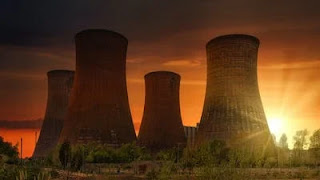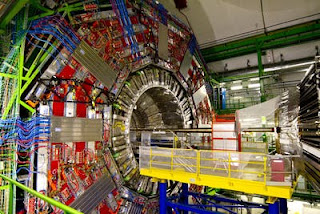The Large Nuclear Accelerator or the Large Hadron Collider

(LHC) is the biggest atom smasher and the most elevated energy and speed on the planet, with a length (in a roundabout state) of around 27 kilometers, and it is fabricated underground at a profundity of around 100 meters in France And Switzerland, close to Geneva, this synchrotron is utilized to impact subatomic particles, protons, with energies of up to 7 TeV (1.12 microjoules). A flood of protons in the gas pedal circuit advances to a speed near the speed of light, with the dynamic energy of 3.5 tera (1 tera = 1012) TeV, and simultaneously, the gas pedal speeds up one more stream of protons the other way (in another roundabout cylinder lined up with the first) to a speed Also near the speed of light, with motor energy of 3.5 TeV. It keeps the speeding up protons alive the container of every roundabout flood, which is 27 kilometers in length, are areas of strength for exceptionally that drink high electrical energy, which requires cooling with fluid helium with a temperature of around 4 Kelvin, or around 270 degrees under zero Celsius.
After the proton motion is advanced quickly to an energy of 3.5 TeV in inverse headings, the transition of protons is projected at specific focuses to meet and impact upward with one another, and the crash energy between every two protons becomes 7 TeV. 4 focuses are assigned for proton impacts on the 27-kilometer Grand Accelerator Circle. At these places, locators (meters) were laid out to record the results of crashes that results from the impact containing all subatomic particles known to us, including electrons, enemies of electrons, protons, enemies of protons, quarks, and others. Researchers desire to find new rudimentary particles that we don't have the foggiest idea about and don't live lengthily, or at least, they rot soon after their initiation and transform again into energyHadron alludes to particles that contain quarks, like the proton and neutron. While the proton has a positive electric charge, the neutron doesn't have an electric charge. Hence, protons can be advanced in a gas pedal or collider by applying an electric field to them and ceaselessly through the gas pedal circuit, and neutrons can't be sped up. This implies that the Large Hadron Collider is only a proton gas pedal, and it is known as the Large because its circle arrives at a width of 27 kilometers on the line between Switzerland and France close to the city of Geneva, and it is constructed 100 meters underground so grandiose beams don't arrive at it that upsets its estimations, and it likewise speeds up particles It at present impacts (2016) with an energy of 14 TeV. Tests were directed that started in 2010, where the collider worked at high energies that we had not reached previously.
One of its most significant outcomes up to this point (May 2017) is to affirm the legitimacy of the Standard Model hypothesis of rudimentary particles (parts of issue). The collider has found numerous new hadrons and quark-gluon plasmas, as found in the Bs0-meson. It deteriorates into kaon and pion and furthermore seldom breaks down into 2 muons.
One of the greatest accomplishments of the Large Hadron Collider is the research facility's disclosure of the Higgs-Bosons. The 2013 Nobel Prize in Physics was granted to François Englert and Peter Higgs, creators of the Higgs system. The Large Hadron Collider is wanted to work until 2030, and its energy will be expanded to around 33 TeV by supplanting its magnets and guides, and the interior counters in its finders will be supplanted by additional delicate ones later on. Researchers trust that the Large Hadron Collider will give results about the dim matter that stargazers are calling for. Hence, molecule physicists and stargazers hold hands to address the quandary: Is there dull matter in the universe? The hunt proceeds.
1- its motivation
- One of them will manage the most essential inquiries in physical science, which are issues connected with the development and comprehension of the universe by figuring out the particles that make up the universe, their sorts and methods of communication among them, and a more profound comprehension of the laws of nature and the rise of the universe, its state, and its predetermination.
- The collider is situated in a 27 km (17 mi) periphery tube at a profundity of 175 meters (574 ft) beneath the Franco-Swiss boundary close to Geneva.
- The European Organization for Nuclear Research (CERN) embraced the development of the Large Hadron Collider as mind-boggling, energy for what can be gotten from the revelations of rudimentary particles, through logical examination of particles at high rates, specifically checking the presence of the speculative Higgs boson and the enormous group of new particles that Predicted by supersymmetry. The Large Hadron Collider is subsidized by the European Organization for Nuclear Research, and more than 10,000 physicists and designers from 100 nations and many colleges and labs have worked together on its development.
- The disclosures that the Large Hadron Collider will accomplish are connected with addressing essential inquiries in the field of nature, concerning physicists, including the laws of communication between the various powers influencing rudimentary particles, how to construct the universe from those particles, reality, and the quantum impact of quantum mechanics and the hypothesis of relativity, as what we have reached Yet from the speculations stays questionable completely. This is because every one of these hypotheses can make sense of one piece of nature and can't make sense of other more extensive support points. Among the inquiries that the consequences of the Large Hadron Collider desire to answer are the accompanying:
2- methods of activity
- The Hadron Collider Tunnel contains two equal roundabout cylinders with a measurement of 2.5 centimeters and a cylinder circuit of 27 kilometers. A surge of protons is advanced quickly in inverse bearings in the cylinders. The cylinders meet at four focuses on the two gas pedal circuits, where protons impact.
- In the cylinders, the protons are sent in radiates with a cross-segment of 16 micrometers and a bar length of 8 centimeters. Each group contains around 115 billion protons. At the point when completely functional, the collider's two circuits contain around 2,800 proton radiates pivoting at a recurrence of 11 kilohertz. At the convergence of the proton radiates, they crash, at a pace of 25 nanoseconds.
3- tests
- The surges of inverse protons impact and meet at specific focuses on the gas pedal's way, and at these focuses are the enormous estimating instruments that make it conceivable to record every one of the particles made by the crash of two protons. The pre-arranged estimating instruments are situated in underground rooms and incorporate the ATLAS finder, the CMS muon locator, LHCb, the ALICE examination, and TOTEM (see figure). The heaviness of the Atlas indicator is around 7000 tons and the CMS finder is around 12000 tons. These two indicators (molecule counters) have been uncommonly arranged to ensure that every one of them is estimated independently. If one of them records a bizarre molecule with specific determinations, this can be confirmed by the other scale.

